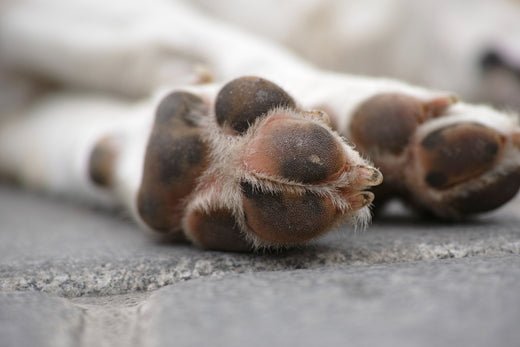How to Care for Your Dog’s Paw Pads
January 15, 2025

Published: November 2023 | Updated: January 2025
Our dogs’ paws serve many functions. They’re not just for walking and running. Sure, they help with stuff like absorbing the shock to joints while they’re jogging along next to you, but they also provide insulation to protect your dog from hot and cold temperatures.
Paw pads are responsible for helping your dog walk in the heat of summer and the ice of winter (although they shouldn’t stay out too long in this weather). They also help our dogs detect subtle changes in the terrain and – even though their claws aren’t retractable like your kitty’s – the paw pads and claws can still help them grab onto surfaces.
The paws of our dogs are intricate, highly functional, and require proper care to stay in good shape.
Basic Anatomy of Dog Paws
Understanding the anatomy of a dog's paw helps in appreciating how vital they are for a dog's daily activities and overall health. The complex anatomy just goes to show how much is going on down there!
Each part of the dog paw plays a vital role in mobility and overall well-being. Here is a quick overview of these parts:
- The Paw Pads: This is the thick, spongy, shock-absorbing part of the paw, which provides cushioning to protect bones and joints from impact. These pads are made of a tough, fatty tissue that insulates against extreme weather.
- Claws or Nails: Help with grip and provide traction, especially when running or changing direction quickly.
- Digital and Metacarpal Pads: Support the dog's weight and assist in movement. This is where numerous sweat glands live, which help regulate body temperature.
- Fur Between the Toes: Protects against extreme temperatures and helps with grip on slippery surfaces.
Underlying all this is a complex network of bones, tendons, ligaments, and connective tissue, which work together to provide support, mobility, and flexibility.
Paw Pads on Dogs Keep Their Feet Cozy Via Blood Flow
Japanese scientists discovered that dogs have a special system in their paws that stops them from getting too cold and helps keep their whole body warm.
In a dog's paw pad, there are arteries that are very close to veins. This closeness allows heat to move from one blood vessel to another. The system works by using the warm blood from the dog's body to heat up the blood that got cold from touching a cold surface.
Then, this warmed-up blood goes back into the dog's body, keeping both the paws and the internal organs at a good temperature.
BUT, that does not mean you should let them stay out longer than they should. Follow the rule: If you’re hot, they’re hot and if you’re cold, they’re cold.
Different Foot Types Among Dog Breeds
Dogs, with their wide range of breeds, have a variety of foot types, each adapted to specific functions and environments.
The different foot types among dog breeds include:
- Cat Feet: Similar to the paws of a cat, these are compact and round with well-arched toes. Breeds like the Doberman Pinscher and the Akita have cat feet. This type of foot is efficient for endurance and provides good support.
- Hare Feet: Longer than other types, with the two central toes significantly longer than the outer toes, resembling a rabbit’s foot. Breeds like Greyhounds and Borzois, which are fast and have a running gait, often have hare feet.
- Webbed Feet: Characterized by skin between the toes, these feet aid in swimming. Breeds like the Labrador Retriever and the Newfoundland have webbed feet, making them excellent swimmers.
- Splayed Feet: These feet have a more spread-out appearance with noticeable gaps between all toes. While not ideal for most breeds, they are often seen in dogs selectively bred for specific work in challenging environments, like some hound breeds.
What’s With the Cornchip Smell?
The distinctive corn chip-like smell often noticed on dog's feet is commonly referred to as "Frito feet." Yep, you heard correct. Frito feet, as in your dog's feet smell like a bag of chips.
This odor is primarily due to the presence of bacteria and yeast on the dog's skin.
Dogs have sweat glands in their paws, and when they sweat, the moisture becomes a breeding ground for bacteria. These bacteria are natural and generally harmless, but they can produce a yeasty, corn chip-like smell as they proliferate in the warm, moist environment of a dog's paws.
To top it off, dogs are constantly walking on different surfaces, picking up various microorganisms along the way. The interaction of these microbes with their paw sweat can intensify this distinctive odor.
While this smell is usually nothing to worry about, if it's accompanied by other symptoms like excessive licking, redness, or swelling, it could indicate an infection or allergy, and a vet visit might be needed.
Regular grooming and cleaning of your dog's paws can help manage the smell, but some scent is normal due to the natural presence of bacteria on the skin.
Watch for Dog Paw Pad Injury and Problems
Keeping your dog's paws healthy is crucial for their overall well-being. Here's a list of things to watch for to ensure their paws remain in good condition:
-
Pad Condition: Check for cracks, wounds, or dryness on the pads. Healthy pads should be supple and smooth, not overly rough or cracked.
-
Nail Length: Keep an eye on the length of your dog's nails. Overgrown nails can cause discomfort and lead to problems walking or running.
-
Between the Toes: Inspect the areas between your dog's toes. Look for signs of irritation, redness, swelling, or foreign objects like burrs or thorns.
-
Licking or Chewing: If your dog excessively licks or chews their paws, this can be a sign of allergies, infections, or other irritations.
-
Odor and Discharge: Be aware of any unusual odor or discharge from the paws, which could indicate an infection.
-
Temperature and Weather: Protect your dog's paws from extreme temperatures. Hot asphalt in summer, as well as ice and salt in winter, can cause damage.
-
Paw Hair: Trim the hair between the pads if it's too long, as it can collect debris or form painful mats.
-
Moisture: Ensure your dog's paws are dry after they get wet, to prevent infections, especially between the toes.
-
General Appearance: Look for any swelling, redness, or changes in the appearance of the paws.
- Gait Changes: Pay attention to changes in your dog’s walk. Limping, reluctance to walk, or favoring one leg could be a sign of paw discomfort or injury.
Regularly examining your dog’s paws and addressing any issues promptly can help keep them healthy and prevent discomfort or more serious health issues.
Keeping Paw Pads Healthy with Probiotics
This is a bit shocking, but probiotics can help keep your dog’s paws healthy! I know just what you’re thinking: Probiotics help the gut, not anything else. BUT, gut health is actually connected to every system in your dog’s body (and your own).
Here’s how probiotics, like Daily Dog, can help your pup’s pads:
- Boosting Immune Function: Probiotics help strengthen the immune system. A robust immune system can better protect the paw pads from infections and diseases, including those caused by bacteria or fungi that dogs may encounter while walking.
- Promoting Healthy Skin: Probiotics can contribute to healthier skin overall, which includes the skin on paw pads. They help balance the skin's microbiome, which is crucial in preventing infections and promoting quicker healing of any cracks or wounds.
- Reducing Inflammation: Some probiotics have anti-inflammatory properties. Inflammation can be a response to injury or infection in paw pads. By reducing inflammation, probiotics can help soothe irritated paws and aid in healing.
- Enhancing Barrier Function: The skin’s barrier function is essential in protecting against environmental hazards. Probiotics can help strengthen this barrier, offering better protection for the paw pads against harsh surfaces, chemicals, and extreme temperatures.
- Improving Nutrient Absorption: By enhancing gut health, probiotics improve the overall absorption of nutrients. Better nutrient absorption can lead to healthier skin and, consequently, healthier paw pads.
Take All the Steps
Take a deep breath. I know this sounds like a lot of information, but here are the key points I want you to take with you:
- Probiotics can significantly help improve your dog's overall health including their paw pads.
- Keeping your dog’s paws clean is super important to prevent infection.
- Check your dog’s paw pads frequently to ensure they’re healthy.
You are on the path to optimal dog paw pad health, so you and your pup can share many more miles together.
Photo by engin akyurt on Unsplash

Research Citations
- 1) Dogs' Feet Give Japan Scientists Paws for Thought, https://www.reuters.com/article/us-japan-dogs/dogs-feet-give-japan-scientists-paws-for-thought-idUSTRE81Q15620120227?feedType=RSS&feedName=oddlyEnoughNews
- 2) How Does the Canine Paw Pad Attenuate Ground Impacts? A Multi-Layer Cushion System, https://www.ncbi.nlm.nih.gov/pmc/articles/PMC5769641/
